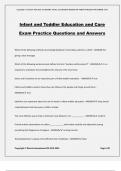Exam (elaborations)
Infant and Toddler Education and Care Exam Practice Questions and Answers
Infant and Toddler Education and Care
Exam Practice Questions and Answers
Which of the following methods of providing feedback is most likely useful for a child? - ANSWER-
giving a clear message
Which of the following sentences best defines the term "positive reinforcement?" - ANSWER-it is a
r...
[Show more]
Preview 4 out of 42 pages
Uploaded on
November 4, 2024
Number of pages
42
Written in
2024/2025
Type
Exam (elaborations)
Contains
Questions & answers
Institution
Prep Tests
Course
Prep Tests
$12.49
100% satisfaction guarantee
Immediately available after payment
Both online and in PDF
No strings attached
Copyright © KAYLIN 2024/2025 ACADEMIC YEAR. ALL RIGHTS RESERVED FIRST PUBLISH NOVEMBER, 2024




